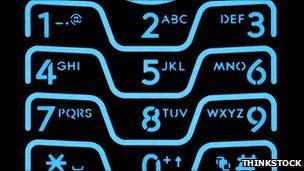Go Figure: Do we understand 'risk' of mobile phone use?
- Published
- comments
What should we make of recent news reports speculating about whether mobile phones cause cancer? It's all about how we deal with uncertainty, says Michael Blastland in his regular column.
How risky is it if you don't know the risks?
Daft question? Possibly. But perhaps it helps define who we are. Here is an exercise which invites you to a little self-diagnosis of your attitudes towards risk.
Mobile phones may cause brain cancer. "Shock warning!" said one newspaper when it reported this last week. "Shock U-turn" said another. Others seemed more sanguine.
Why the difference? Because all were reacting in their own way to ignorance. As this BBC report and others, like the Guardian's Ben Goldacre,, external pointed out, we simply don't know how risky mobile phone are.
So the word "may", as in the BBC headline "may cause cancer", is everything. Is it scary? Or reassuring? What if we turned it round and said "may not cause cancer"?
Risk often isn't about hard numbers - often there are no hard numbers - it's about how we react to uncertainty, given how the uncertainty is presented to us.
The graphic below is based on an illustration famously used by Prof John Adams, a writer about risk, for the cover of a book - called Risk, naturally.
As this graphic suggests, what we know is negligible. The rest, as Prof Adams puts it, is darkness.
The data he cited - about five million known chemicals (the whole area of the graphic), 7,000 tested for carcinogenicity (the yellow rectangle), 30 known to cause cancer in humans (the tiny orange area at the top left) - is a little old now. But his argument stands. Scroll down.

So does the darkness - the huge grey area - say to you "worry"? Or does it say "relax"? The less conclusive the science, the more our personal biases and presumptions - filters, Adams calls them - come into play. These are optimism, pessimism, trust or mistrust of authority, desire for personal control, and so on.
These are what often define riskiness for us. And so by helping to reveal them, our attitude to risk helps tell us who we are.

The classification of mobile phone risk has not changed, whatever news reports might imply
The International Agency for Research on Cancer (IARC) puts risks in one of five categories - carcinogenic, probably carcinogenic, possibly carcinogenic, not classifiable or probably not carcinogenic.
Mobile phones are "possibly" and so also, logically, "possibly not". That classification has not changed, despite recent news reports. Didn't know before, don't know now.
Scary headlines based on nothing new are nothing new, if you see what I mean. But newspapers won't be alone in taking the view that "don't know = grounds for fear", believing an "admission" of uncertainty makes the world more dangerous.
It's worth pointing out too that the IARC classification is not about how big a risk is, simply about how strong the evidence is that there is a risk, whether big or small.
We'd probably have an idea by now if any risk attached to mobile phones was big (unless the damage waits for old age). We haven't found it despite looking pretty hard.
Brain cancer is rare, about 10 cases in every 100,000 people. Let's say heavy mobile phone use doubles that risk over 20 years. Not true, so far as we know, but let's run with it. That would mean that among 100,000 heavy phone users, the number of brain cancers would rise from 10 in 100,000 to 20 in 100,000.
Does that reassure you? Or by failing to rule out a risk of unknown size, has it simply raised your suspicions?
It would be a surprise if any evidence here persuaded anyone out of a view they already held, and in any case it's not meant as a recommendation.
Arguments about risk are seldom settled by evidence - partly because the evidence can be fiendishly hard to detect or agree. What's left is how we feel in the dark.